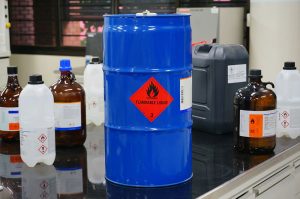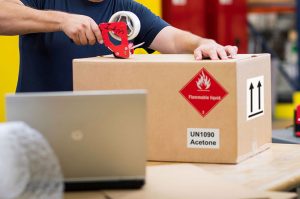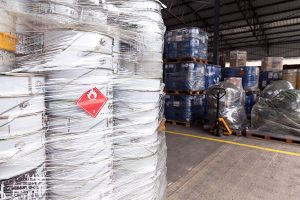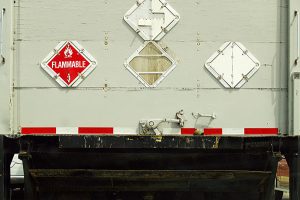
DOT separates hazardous materials into nine categories or “hazard classes.” They are defined by specific hazardous properties and have distinct regulatory requirements for packaging, markings, and labels. Many the classes have divisions, for example, flammable solids are solid (match sticks), spontaneously combustible (rags soaked in lacquer thinner), and dangerous when wet (magnesium fire starter). Labels use color, symbol, and number to clearly state the hazard.
DOT and NFPA define flammable liquid a little differently. DOT uses “flammable” for any liquid with a flash point of 100°F or less. NFPA makes distinctions based on the flash point.
| NFPA Class | Flash Point | Boil Point | Examples |
| IA | < 73°F | < 100°F | Diethyl Ether, Ethylene Oxide, some light crude oil |
| IB | < 73°F | +> 100°F | Motor and Aviation Gasolines, Toluene, Lacquers, Lacquer Thinner |
| IC | 73–99°F | Xylene, some paints, some solvent‐based cements | |
| II | 100–139°F | Diesel Fuel, Paint Thinner | |
| IIIA | 140–199°F | Home Heating Oil | |
| IIIB | =>200°F | Cooking Oils, Lubricating Oils, Motor Oil |
Transporting Hazmat
DOT has specific requirements for freight carriers, that includes driver training and vehicle inspections. PHMSA requires that once each calendar month the driver:
- Visually inspect each delivery hose
- Visually inspect the piping system and all its components
- Actuate all emergency discharge control devices to ensure the self-closing stop valve and all linkages operate as designed
- Visually inspect the self-closing stop valve
In-depth inspections are conducted annually or every five years, and states have more-stringent requirements for inspections. Despite these regulations, unsafe vehicles may be on the road. During a five-day inspection blitz in the U.S., Canada, and Mexico in October 2021, inspectors identified 2,714 violations in the 13,471 trucks they examined.
When loaded with any hazardous materials, trucks or railcars are never allowed to be left unattended.
Packaging and Shipping Containers
The shipper is required to use an approved shipping container for the hazard, label the outside of the package or container, and complete a shipping manifest that lists the hazard so that the transportation company knows that they hazardous materials.
Click a photo to enlarge.
Small amounts of hazardous materials, like paint, nail polish (lacquer), or cooking oil, may be on a local delivery trucks because the sender doesn’t know that the material is hazardous. Please share this video with the people in your community and visit Check the Box.
Bulk Hazmat in Your Community
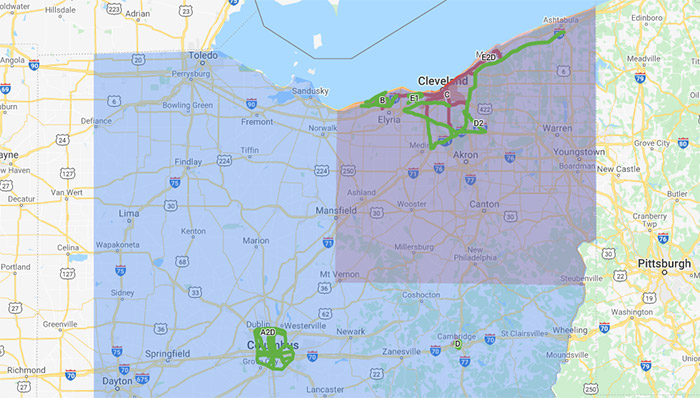
FMCSA maintains a registry of routes that are restricted for some or all hazardous materials and displays a map and PDF and Excel files that give more detail. Each state’s department of transportation have more detailed routing publications for roadways and rail lines on which bulk hazmat is prohibited.
The best way to identify flammable, toxic, corrosive, and other dangerous materials on the road and rail is to know the shippers and recipients in your community, and the transportation companies that are authorized to transport hazmat materials through your city, town, or tribal lands.
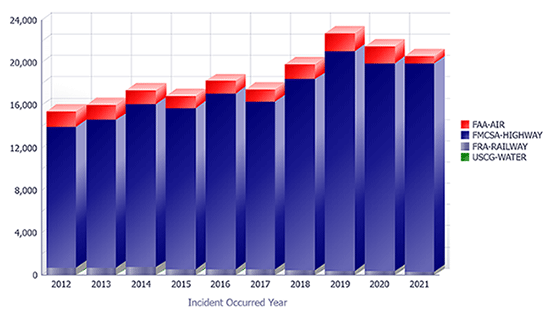
PHMSA maintains an incident database with a summary report for the state and tribal land, and a search tool that provides more detail. By entering your city and state as either the location of the incident or the origin city gives you a good idea of bulk hazmat you may encounter.
